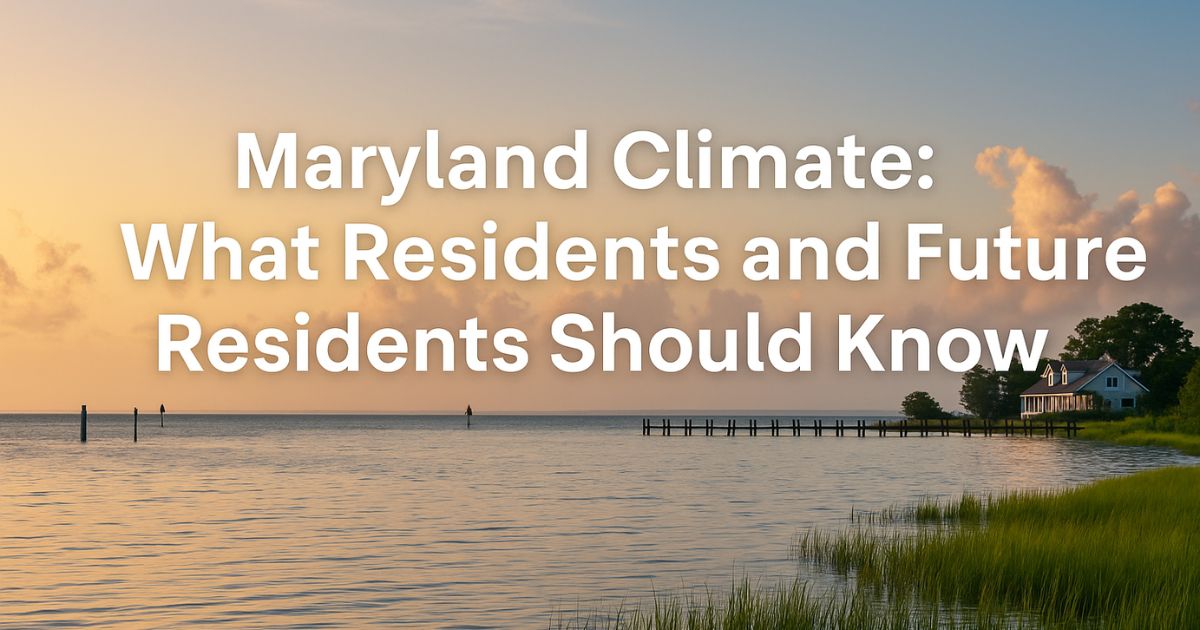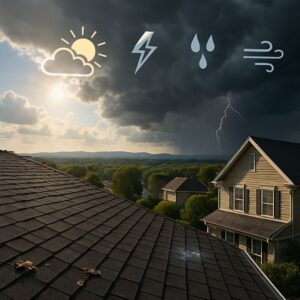
A State Shaped by Land and Water
The Maryland climate is as diverse as the state’s geography—spanning coastal plains, urban areas, rolling farmland, and the world-famous Chesapeake Bay. Often called “America in Miniature,” Maryland sits at the intersection of northern and southern U.S. weather systems. This strategic location makes the state highly vulnerable to climate change, especially in low lying areas and along the coast.
According to the Fourth National Climate Assessment and data from the Global Change Research Program, the changing climate in Maryland is accelerating. As greenhouse gas emissions continue, scientists project rising sea levels, stronger storms, and more very hot days throughout the free state.
Seasonal Climate Patterns in Maryland
- Winter (December–February):
In Baltimore, Washington, and College Park, low temperatures dominate the season (months like January can be rough), though warmer winters have become more common over the last century. Occasional drought conditions and strong winds disrupt normal patterns, while colder weather lingers longer on the coastal plain and southern Maryland. - Spring (March–May):
Spring brings welcome precipitation and renewal, but also rising risk of flooding events, particularly in urban areas and low lying areas impacted by tidal flooding. Annual precipitation remains high, contributing to expanding flood hazard areas across the eastern shore. - Summer (June–August):
Characterized by humid summers, heat waves, and an increase in very hot days—sometimes topping 100 degrees Fahrenheit—this season presents real risks to human health and infrastructure. Extreme heat is now a major threat in both rural and city environments. - Fall (September–November):
Maryland’s fall season sees a drop in average temperatures, but flooding persists due to storm surge, tropical systems, and continued sea level rise. This is especially problematic in Ocean City and the lower eastern shore.
How Maryland’s Climate Affects Daily Life
The climate of Maryland plays a central role in shaping transportation, property planning, agriculture, and public safety. With more flooding expected in coastal and urban areas, Maryland residents are urged to stay alert to projected changes in weather and infrastructure demands.
The Maryland Commission on Climate Change, backed by environmental science experts, works with municipalities to address greenhouse gas emissions, develop resilient systems, and share environmental information on evolving risks like high tide flooding, air pollution, and ecosystem disruption.
Roofing and Resilience in a Changing Climate
For Maryland homeowners, the weather is more than an inconvenience—it’s a direct threat to home safety. At Varner Roofing, we’ve seen firsthand how climate affects land, materials, and structures. From humid summers warping shingles to winter freeze-thaw cycles causing leaks, it’s essential to install systems that withstand these extremes.
Living near the coast, in Baltimore, or on the eastern shore? You need solutions that hold up to storm surge, strong winds, and relative sea level rise. Our team provides weather-informed roof installation and maintenance throughout Maryland, offering solutions tailored to both climate models and real-world events.
Explore our local Maryland roofing services:
- Frederick MD roofing services
- Glen Burnie MD roofing services
- Maugansville MD roofing services
- Pasadena MD roofing services
- Annapolis MD roofing services
- Rockville MD roofing services
- Severna Park MD roofing services
- Hagerstown MD roofing services
- Smithsburg MD roofing services
- Waldorf MD roofing services
Our expert team offers free estimates and reliable solutions designed to withstand West Virginia climate extremes.
The Bigger Picture: Climate Change & the Future of Maryland
The National Centers for Environmental Information and Volume II of the Fourth National Climate Assessment offer sobering insights: if higher emissions persist, projected change includes more frequent hot days, more flooding, and intensified weather across Maryland.
In areas like Ocean City and the eastern shore, sea level is rising faster than the global average. The orange bars found in NOAA’s projections chart sea level rise and show how relative sea level rise is expanding flood hazard areas, endangering homes and roads. These aren’t just theoretical risks—they impact the well being of Maryland residents today.
FAQs About Maryland’s Climate
How is Maryland’s climate unique compared to other states?
Maryland’s mix of coast, urban areas, coastal plain, and mountains makes it one of the most geographically diverse states in the country. This leads to variable weather and localized climate impacts that differ from other states.
What is the average annual precipitation in Maryland?
The average annual precipitation is between 40 and 50 inches. Southern Maryland, the eastern shore, and Baltimore experience the highest levels, often leading to flooding during heavy rain.
What’s causing the rise in sea level?
A combination of global climate change, melting polar ice, and human activities like coastal development has led to rising sea levels in Maryland. The relative sea level rise here is among the fastest in the mid Atlantic region.
How do climate models predict future change?
Climate models based on NOAA and the global change research program suggest Maryland will face more extreme heat, tidal flooding, and shifts in annual precipitation, especially under scenarios with higher emissions.
What are the main risks to property in Maryland?
Homes in low lying areas near Chesapeake Bay, urban areas, or close to the coast are at the highest risk due to flooding, storm surge, and strong winds from hurricanes and nor’easters.
What is Maryland doing to address climate change?
Through the Maryland Commission and local efforts, the state is working to cut emissions, share environmental information, and prepare communities for projected climate conditions.
What role do human activities play in Maryland’s changing climate?
Activities like urban expansion, deforestation, and increased emissions have contributed to warming temperatures, poor air pollution, and climate volatility, especially in cities like Baltimore and Washington.
Has the winter season changed in Maryland?
Yes. Winters now see warmer winters, fewer snow events, and more ice-related disruptions—changes that have accelerated since the last century.
Why is Chesapeake Bay so important in this conversation?
The Chesapeake Bay is an ecological and economic hub. Flooding, air pollution, and climate change all threaten its biodiversity and the industries that rely on its health.
Where can I find trustworthy data about Maryland’s climate?
Sources include the Fourth National Climate Assessment, NOAA’s Volume II report, and data from national centers such as the Global Change Research Program and NASA’s College Park Earth Sciences Lab.



